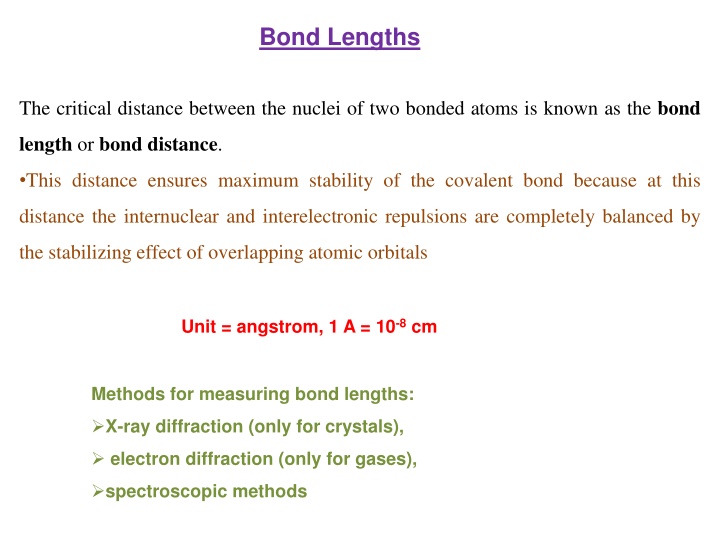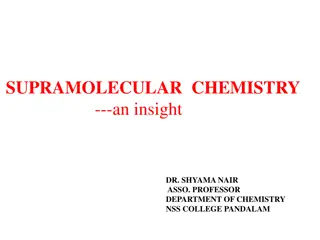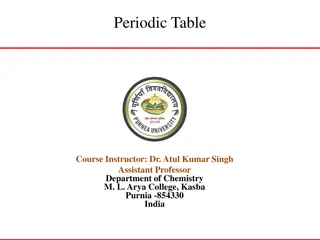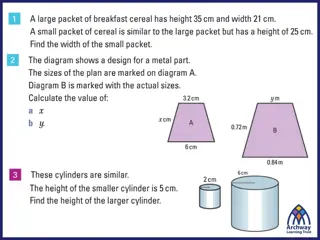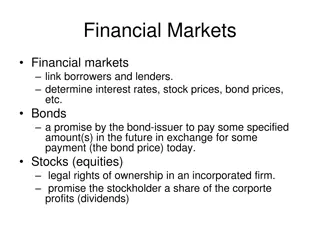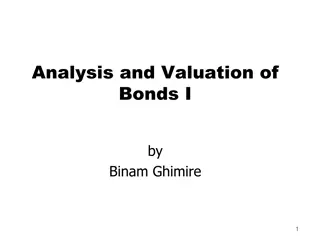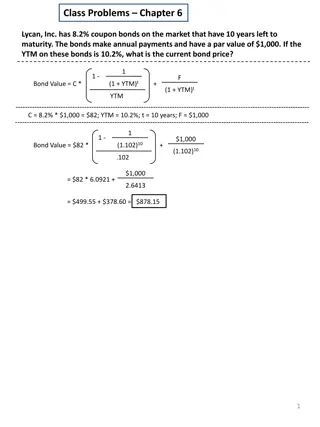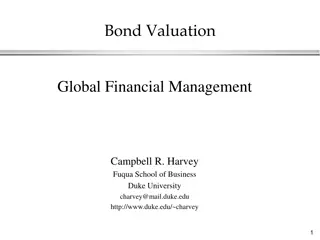Bond Lengths and Strengths in Chemistry
Bond lengths represent the critical distance between bonded atoms for maximum stability, while bond strengths are measured through dissociation energy and average bond energy. Methods for measuring bond lengths include X-ray diffraction and spectroscopic methods, with bond energies reflecting the strength of atomic bonds. Shorter bonds are stronger, with double bonds being shorter and stronger than single bonds due to enhanced electron-nuclei attraction. Various factors influence bond dissociation, such as resonance and steric effects.
Download Presentation

Please find below an Image/Link to download the presentation.
The content on the website is provided AS IS for your information and personal use only. It may not be sold, licensed, or shared on other websites without obtaining consent from the author.If you encounter any issues during the download, it is possible that the publisher has removed the file from their server.
You are allowed to download the files provided on this website for personal or commercial use, subject to the condition that they are used lawfully. All files are the property of their respective owners.
The content on the website is provided AS IS for your information and personal use only. It may not be sold, licensed, or shared on other websites without obtaining consent from the author.
E N D
Presentation Transcript
Bond Lengths The critical distance between the nuclei of two bonded atoms is known as the bond length or bond distance. This distance ensures maximum stability of the covalent bond because at this distance the internuclear and interelectronic repulsions are completely balanced by the stabilizing effect of overlapping atomic orbitals Unit = angstrom, 1 A = 10-8 cm Methods for measuring bond lengths: X-ray diffraction (only for crystals), electron diffraction (only for gases), spectroscopic methods
Since molecules are always vibrating the distance between atoms of a bond is not constant. Therefore, the measurements obtained are average values and different methods give different values.
Bond Strengths (Bond Energies) There are two measures of bond strengths : (i) Bond dissociation energy (D) and (ii) Average bond energy (E) Bond dissociation energy (D): The energy required to break a particular bond (in the gaseous phase) to give free radicals (in the gaseous phase) is called the dissociation energy, D The greater the bond dissociation energy, the stronger is the bond.
Average bond energy (E): In poly atomic molecules, bond dissociation energies (D) are not identical even where apparently equivalent bonds dissociate For example, four equivalent C-H bonds dissociate successively, they have different values of D, 102 kcal/mole for CH3-H, 105 kcal/mole for CH2-H, 108 kcal/mole for CH-H, Methane 83 kcal/mole for C-H. Average value of the C-H bond energy = (102 + 105 + 108 + 83)/4 = 99.5 kcal/mole
The dissociation of a bond also depends on various factors Resonance, Hyperconjugation Hybridisation, Angle strain, Steric effects, etc. Usually average of all the D values of equivalent bonds is taken, and this average value is called the bond energy (E). Bond energy (E) may be measured from heat of atomization, but the more usual practice is to calculate it from the heat of combustion.
Bond energies are measures of bond strengths. Shorter bonds are stronger bonds due to stronger- attraction between nuclei and electrons. Double bonds are both shorter and stronger than single bonds, but not twice strong, because overlapping is weaker than overlapping
Bond Angles All atomic orbitals (except s orbital) have directional preferences, hence covalent bonds formed by their overlapping are also directional and have an angle between them. The angle between the directions of two covalent bonds is known as the bond angle The most important methods for determining bond angles are X-ray diffraction (only for crystals), electron diffraction (only for gases) and spectroscopic methods. Due to continuous atomic vibrations in molecules, the measured bond angles are average bond angles
Bond angles give an idea of the geometries and shapes of molecules, as they depend on bond angles Order of repulsions between electron pairs in the valence shell : lone pair-lone pair > lone pair-bond pair > bond pair-bond pair This order can be explained on the basis that the lone pair is under the influence of only one nucleus, hence its electron cloud will spread out in space to a greater extent than that of a bond pair, which is under the influence of two nuclei. This greater spread over of electron cloud in space results in a greater repulsion between a lone pair and another lone pair than that between a lone pair and a bond pair, and there is least repulsion between a bond pair and another bond pair of electrons.
Hybridisation This mixing and redistribution of energy is called hybridisation and the resultant orbitals are called hybrid orbitals. Hybridisation is a hypothetical concept and has been introduced by Pauling and Slater Hybridisation Rules 1. The orbitals of similar energies take part in hybridisation. 2. Number of hybrid orbitals formed is always equal to the number of atomic orbitals which have taken part in the hybridisation. 3. Generally, all the hybrid orbitals are similar but they are not necessarily identical in shape. They may differ from one another mainly in shape. 4. Hybrid orbitals form only sigma bonds
sp or Digonal Hybridisation : In this type of hybridisation one s and one p-orbital of the valence shell of central atom of the given molecule combine to form two sp hybrid orbitals as follows:
Characteristic of sp-Hybrid Orbitals 1. Both sp-hybrid orbitals are completely equivalent and symmetrical. 2. Energy of sp-hybrid orbital is more than s-orbital but less than the p- orbital. 3. These two sp-hybrid orbitals are collinear, i.e., angle between the hybrid orbitals is 180 . 4. Shape of sp-hybrid orbital is oval. 5. Its relative power of overlapping is 1.93 with respect to s orbital. 6. In sp-hybrid orbital one lobe is bigger while other lobe is small. The bigger lobe is very large with respect to p-orbital, hence it has higher degree of overlapping. Thus it forms stronger bond.
sp2 or Trigonal Hybridisation : In this type of hybridisation one s and 2p orbitals of the valence shell of central atom of the given molecule combine to form three sp2-hybrid orbitals as shown below:
Characteristics of sp2 Hybridisation : (1) These sp2-hybrid orbitals are completely equivalent and symmetrical. (2) These hybrid orbitals are planar with bond angle 120 . (3) Since in this hybridisation contribution of p-orbitals is more hence it is less oval than sp-hybrid orbitals. In this case one lobe is bigger and one lobe is smaller and it forms stronger bond. (4) These are stronger than s and p orbitals. Its relative power of overlapping is 1.99 with respect to s-orbital
sp3 or Tetrahedral Hybridisation: In this hybridisation one s and three p-orbitals of the valence shell of central atom of the given molecule combine to form four sp3-hybrid orbitals.
Characteristics of sp3 Hybridisation : (1) All the four sp3 hybrid orbitals are completely equivalent and symmetrical. (2) These orbitals are directed towards the four comers of a regular tetrahedron and the angle between each pair of them is 109 28' or 109.5 . (3) Their relative power of overlapping is 2.00 with respect to s-orbital. This shows that sp3 -orbitals are stronger than sp which is stronger than sp- orbitals. (4) Since in sp3-hybridisation the contribution of p-orbitals is 75%, its shape is almost same as that of the parent p-orbitals except that the bigger lobe in sp3 -orbital is somewhat more spread and shorter in length than the pure p- orbitals
Hybridisation in Organic Species Hybridisation in organic species can be known by two methods: First Method: In this method hybridisation can be known by the number of pi bonds present on that particular atom. Example This method cannot be used for those atoms of the molecule which have positive charge, negative charge or odd electron
Second method: Electron pair method ep = bp + lp where ep = electrons pair present in hybrid orbitals bp = bond pair present in hybrid orbitals lp = loan pair present in hybrid molecule Determination of bond pairs : Number of bp = Number of atoms present on central atom of the species
Determination of lone pair of electrons: Number of Ip's can be determined as follows: (i) If carbon has pi bond/(s) or positive charge or odd electron, then lp on carbon will be zero. (ii) If carbon has negative charge, then Ip will be equal to one. Number of electron pairs tells us the type of hybridisation as follows:
Hybridisation and Bond Properties Bond properties like bond angles, geometry of molecules, electronegativity, dipole moments, bond lengths, bond strengths, bond energies and acidity of hydrocarbons are greatly influenced by the hybrid' states of bonded atoms 1. Bond Angles and Geometry of the Molecule: The carbon valency angles follow the following order: sp3 (109.5 ) < sp2 (120 ) < sp (180 )
2. Bond Lengths: An s-orbital is nearer to the nucleus than a p-orbital of the same shell. Hence, a hybrid orbital with more s-character is also nearer to the nucleus and it has smaller size than a hybrid orbital with more p-character. The sizes of different hybrid orbitals follow the following order: sp3 > sp2 > sp
3. Bond Strengths (Bond Energies): Since shorter bonds are stronger bonds. Thus, bond energies (and bond strengths) of bonds in different hybrid states follow the following order: sp3 < sp2 < sp
4. Electronegativity: The power of an atom to attract electrons of a bond is called electronegativity. Since overlapping of orbitals with more s-character have a shorter bond length, consequently their electrons are nearer to the nucleus and will be attracted towards the nucleus with a greater force. This means, the greater is the s-character in a hybrid orbital, the greater will be the electronegativity of the atom in that hybrid state. The order of electronegativities of carbon in different hybrid states is : sp3 < sp2 < sp
5. Acidity of Hydrocarbons: Hydrogen present on electronegative carbon is acidic in character. Acidity of hydrogen is directly proportional to the electronegativity of atom on which hydrogen is present.
CLASSIFICATION OF ORGANIC COMPOUNDS 1. Based on Structure 2. Based on Functional Group 1. Based on Structure
Acyclic or Open-chain compounds : These are the compounds in which the carbon atoms are linked to each other in such a manner that the molecule is having an open-chain structure. The chain of the carbon atoms may be straight or branched. These compounds are also called as aliphatic compounds.
Cyclic or Closed-chain compounds : These are the compounds in which carbon atoms are linked to each other or to the atoms of other elements in such a manner that the molecule has a closed-chain or cyclic or ring structure. The compounds with only one ring of atoms in the molecule are known as monocyclic but those with more than one ring of atoms are termed as polycyclic. These are further divided into two subgroups: (a) Homocyclic or Carbocyclic, (b) Heterocyclic.
(a) Homocyclic or Carbocyclic : These are the compounds having a ring or rings of carbon atoms only in the molecule. The carbocyclic or homocyclic compounds may again be divided into two types: (i) Alicyclic compounds and (ii) Aromatic compounds. (i) Alicyclic compounds : These are the compounds which contain rings of three or more carbon atoms. These resemble with aliphatic compounds than aromatic compounds in many respects. That is why these are named alicyclic, i.e., aliphatic cyclic. These are also termed as polymethylenes.
(ii) Aromatic compounds : These compounds consist of at least one benzene ring, i.e., a six-membered carbocyclic ring having alternate single and double bonds. Generally, these compounds have some fragrant odour and hence, named as aromatic (Greek word aroma meaning sweet smell) . These compounds are also known as benzenoid aromatics as their molecules consist of benzene ring or rings. However, there are aromatic compounds, which have structural units different from benzenoid type, and are known as non-benzenoid aromatics.
(b) Heterocyclic compounds: These are cyclic compounds having ring or rings built up of more than one kind of atoms. The most common other atoms (hetero-atoms) besides carbon are 0, N and S.
Classification Based on Functional Groups The compounds of only carbon and hydrogen are called hydrocarbons. Hydrocarbons are considered as the parents of all the organic compounds. All other compounds are obtained from hydrocarbons by the replacement of one or more hydrogen atoms with other atoms or groups. most of the organic compounds consist of two parts, each of which is called a group or radical. R = represents the carbon-hydrogen framework affects the physical properties functional group X = responsible for the chemical properties of the compound
Certain compounds contain more than one functional groups. Such compounds are called polyfunctional compounds. The properties of each functional group may be modified by the presence of the others.
Homologous series: A homologous series can be defined as a group of compounds in which the various members have similar structural features and similar chemical properties and the successive members differ in their molecular formula by CH2.
Properties of Homologous series All compounds in the series are composed of same elements and contain the same functional group. All compounds in the series can be represented by one general formula, The molecular mass of every two adjacent members differs by 14 All compounds in the series have similar chemical properties because of the presence of same functional group. The members of the series show a gradual gradation in their physical properties like solubility, density, melting and boiling points. The physical properties generally increase as the molecular mass increases. The homologues can be prepared by almost similar methods. These are known as general methods of preparation
SATURATED AND UNSATURATED COMPOUNDS If, in an organic compound containing two or more carbon atoms, there are only single bonds between carbon atoms, then the compound is said to be saturated, e.g., ethane, n-propyl alcohol, acetaldehyde, etc If the compound contains at least one pair of adjacent carbon atoms linked by a multiple bond, then that compound is said to be unsaturated, e.g., ethylene, acetylene, vinyl alcohol, acraldehyde, etc.
